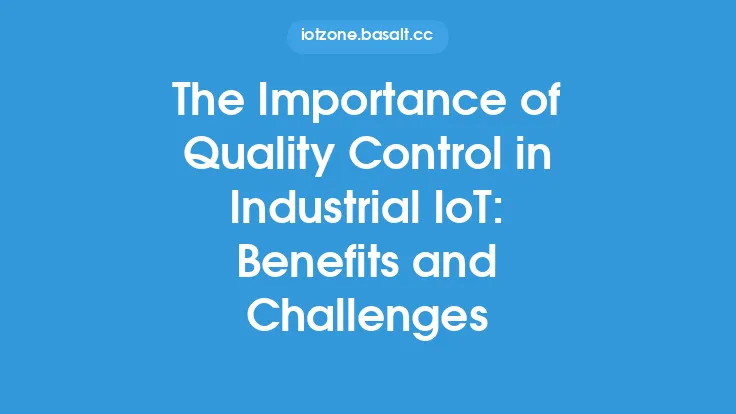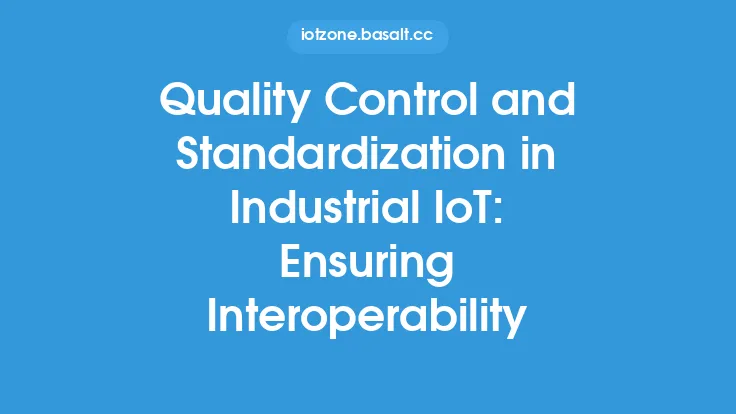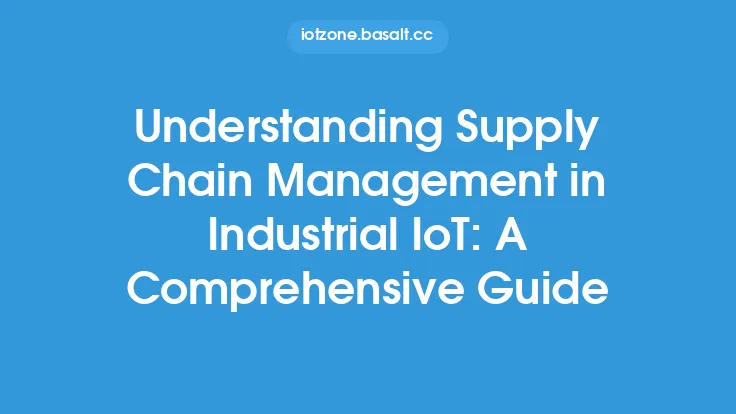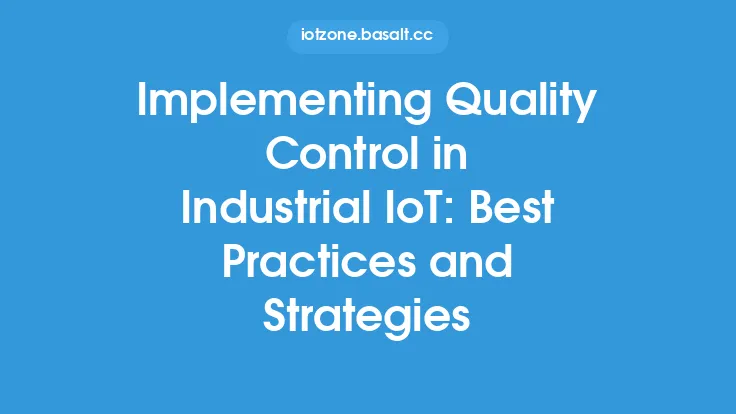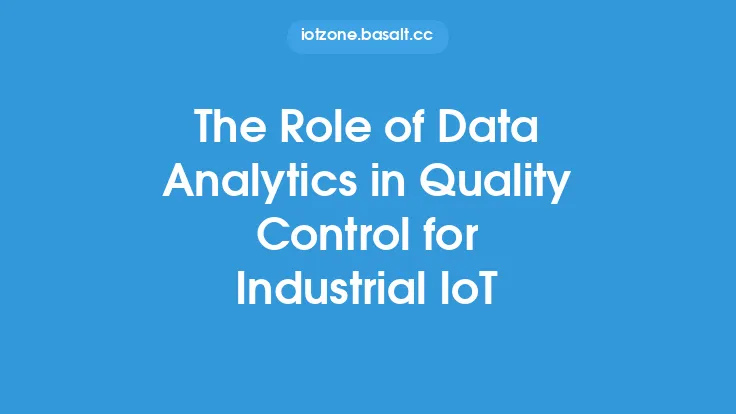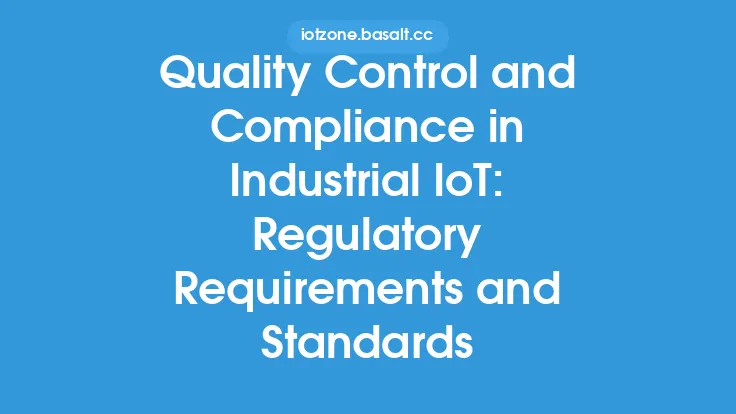Quality control is a critical component of Industrial IoT (IIoT) that ensures the reliability, efficiency, and consistency of industrial processes and products. In the context of IIoT, quality control refers to the systematic process of monitoring, controlling, and improving the quality of products, processes, and services. This is achieved through the use of advanced technologies such as sensors, machine learning algorithms, and data analytics.
Introduction to Quality Control in IIoT
Quality control in IIoT involves the use of various techniques and tools to monitor and control the quality of products and processes in real-time. This includes the use of sensors and machine learning algorithms to detect anomalies and predict potential quality issues. The goal of quality control in IIoT is to ensure that products meet the required standards and specifications, and that processes are optimized to minimize waste and reduce costs.
Key Components of Quality Control in IIoT
There are several key components of quality control in IIoT, including:
- Sensors and Data Collection: Sensors are used to collect data on various parameters such as temperature, pressure, and vibration. This data is then used to monitor and control the quality of products and processes.
- Machine Learning Algorithms: Machine learning algorithms are used to analyze the data collected by sensors and detect anomalies and patterns. This helps to predict potential quality issues and take corrective action.
- Data Analytics: Data analytics is used to analyze the data collected by sensors and machine learning algorithms. This helps to identify trends and patterns, and make informed decisions about quality control.
- Automation and Control: Automation and control systems are used to control and adjust processes in real-time. This helps to ensure that products meet the required standards and specifications.
Quality Control Process in IIoT
The quality control process in IIoT involves several steps, including:
- Planning: The first step in the quality control process is planning. This involves identifying the quality standards and specifications that must be met, and developing a plan to achieve them.
- Monitoring: The next step is monitoring. This involves using sensors and machine learning algorithms to collect data and monitor the quality of products and processes in real-time.
- Analysis: The data collected during monitoring is then analyzed using data analytics. This helps to identify trends and patterns, and make informed decisions about quality control.
- Control: The final step is control. This involves using automation and control systems to adjust processes in real-time, and ensure that products meet the required standards and specifications.
Benefits of Quality Control in IIoT
The benefits of quality control in IIoT are numerous, and include:
- Improved Product Quality: Quality control in IIoT helps to ensure that products meet the required standards and specifications, and are of high quality.
- Increased Efficiency: Quality control in IIoT helps to optimize processes, and reduce waste and costs.
- Reduced Costs: Quality control in IIoT helps to reduce costs by minimizing waste, and reducing the need for rework and repair.
- Improved Customer Satisfaction: Quality control in IIoT helps to ensure that products meet customer requirements, and are delivered on time.
Challenges of Quality Control in IIoT
Despite the benefits of quality control in IIoT, there are several challenges that must be addressed. These include:
- Data Quality: The quality of data collected by sensors and machine learning algorithms is critical to the effectiveness of quality control in IIoT. Poor data quality can lead to inaccurate analysis, and ineffective control.
- System Integration: Quality control in IIoT requires the integration of multiple systems, including sensors, machine learning algorithms, and automation and control systems. This can be a complex and challenging task.
- Cybersecurity: Quality control in IIoT requires the use of advanced technologies, including sensors and machine learning algorithms. This can create cybersecurity risks, and require additional measures to protect against them.
Technologies Used in Quality Control for IIoT
Several technologies are used in quality control for IIoT, including:
- Industrial Automation: Industrial automation technologies such as programmable logic controllers (PLCs), supervisory control and data acquisition (SCADA) systems, and distributed control systems (DCS) are used to control and monitor industrial processes.
- Machine Learning: Machine learning algorithms are used to analyze data collected by sensors, and predict potential quality issues.
- Internet of Things (IoT): IoT technologies such as sensors, actuators, and communication protocols are used to connect devices, and collect and transmit data.
- Cloud Computing: Cloud computing technologies are used to store, process, and analyze large amounts of data collected by sensors and machine learning algorithms.
Real-World Applications of Quality Control in IIoT
Quality control in IIoT has numerous real-world applications, including:
- Predictive Maintenance: Quality control in IIoT can be used to predict when maintenance is required, and prevent equipment failures.
- Quality Inspection: Quality control in IIoT can be used to inspect products, and detect defects and anomalies.
- Process Optimization: Quality control in IIoT can be used to optimize processes, and reduce waste and costs.
- Supply Chain Management: Quality control in IIoT can be used to track products, and ensure that they meet the required standards and specifications.
Conclusion
In conclusion, quality control is a critical component of IIoT that ensures the reliability, efficiency, and consistency of industrial processes and products. The use of advanced technologies such as sensors, machine learning algorithms, and data analytics helps to monitor and control the quality of products and processes in real-time. While there are several challenges that must be addressed, the benefits of quality control in IIoT are numerous, and include improved product quality, increased efficiency, reduced costs, and improved customer satisfaction. As the use of IIoT continues to grow and expand, the importance of quality control will only continue to increase.
